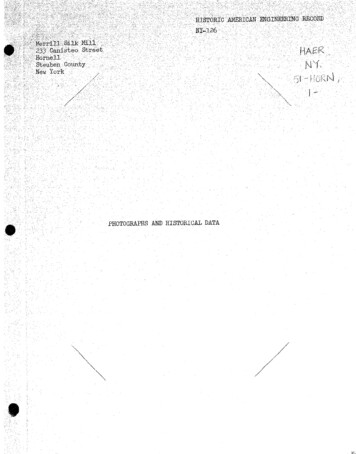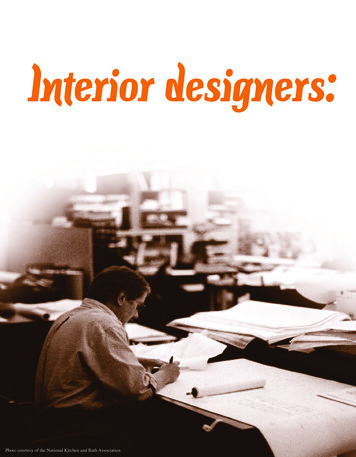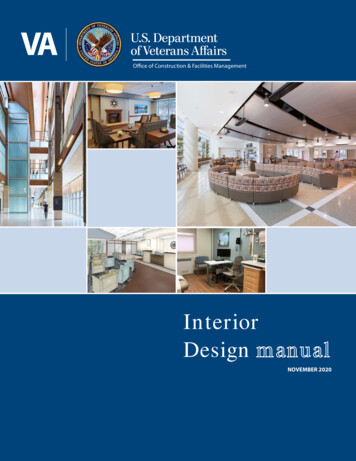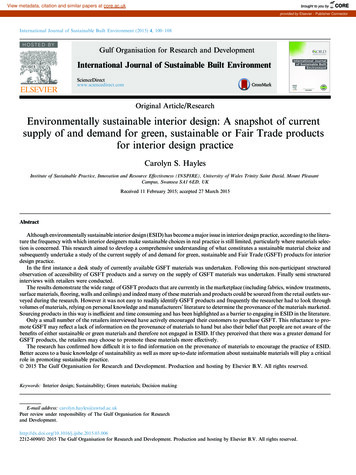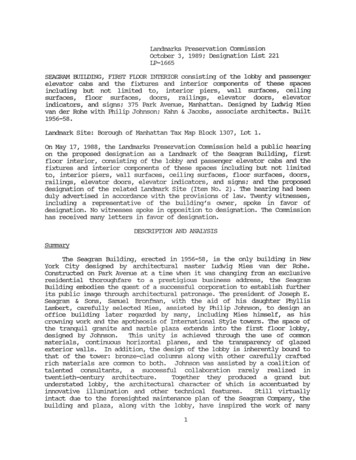
Transcription
I.andmarks Preservation Commissionoctober 3, 1989; Designation List 221IP-1665SEAGRAM BUIIDING, FIRST FLOOR INTERIOR consisting of the lobby and passengerelevator cabs and the fixtures and interior components of these spacesincluding but not limited to, interior piers, wall surfaces, ceilingsurfaces, floor surfaces, doors, railings, elevator doors, elevatorindicators, and signs; 375 Park Avenue, Manhattan. Designed by Ludwig Miesvan der Rohe with Philip Johnson; Kahn & Jacobs, associate architects. Built1956-58.Landmark Site: Borough of Manhattan Tax Map Block 1307, Lot 1.May 17, 1988, the landmarks Preservation Commission held a public hearingon the proposed designation as a Landmark of the Seagram Building, firstfloor interior, consisting of the lobby and passenger elevator cabs and thefixtures and interior components of these spaces including but not limitedto, interior piers, wall surfaces, ceiling surfaces, floor surfaces, doors,railings, elevator doors, elevator indicators, and signs; and the proposeddesignation of the related I.and.mark Site (Item No. 2). The hearing had beenduly advertised in accordance with the provisions of law. Twenty witnesses,including a representative of the building's owner, spoke in favor ofdesignation. No witnesses spoke in opposition to designation. The Commissionhas received many letters in favor of designation.OnDFSCRIPI'ION AND ANALYSISSummaryThe Seagram Building, erected in 1956-58, is the only building in NewYork City designed by architectural master Iudwig Mies van der Rohe.Constructed on Park Avenue at a time when it was changing from an exclusiveresidential thoroughfare to a prestigious business address, the SeagramBuilding embodies the quest of a successful corporation to establish furtherits public image through architectural patronage. The president of Joseph E.Seagram & Sons, Samuel Bronfrnan, with the aid of his daughter PhyllisLambert, carefully selected Mies, assisted by Philip Johnson, to design anoffice building later regarded by many, including Mies himself, as hiscrowning work and the apotheosis of International style towers. The space ofthe tranquil granite and marble plaza extends into the first floor lobby,designed by Johnson.This unity is achieved through the use of conunonmaterials, continuous horizontal planes, and the transparency of glazedexterior walls. In addition, the design of the lobby is inherently bound tothat of the tower: bronze-clad columns along with other carefully craftedrich materials are common to both. Johnson was assisted by a coalition oftalented consultants, a successful collaboration rarely realized intwentieth-century architecture.Together they produced a grand butunderstated lobby, the architectural character of which is accentuated byinnovative illtnnination and other technical features.Still virtuallyintact due to the foresighted maintenance plan of the Seagram Company, thebuilding and plaza, along with the lobby, have inspired the work of many1
subsequent designers and provided arepose.favorable environment for work andHistory of the SitelThe history of Fourth (now Park) Avenue begins with the advent of therailroads. In 1834 the New York and Harlem Railroad first carried passengersalong grade-level tracks down the center of Fourth Avenue from 42nd to 96thstreets. By 1848 the New Haven Railroad entered Manhattan along FourthAvenue. As railroad traffic increased, the avenue was widened to pe:nnitadditional tracks and the city mandated depressed tracks to minimizeproblems of noise, smoke, and the danger of fire and injury. By the 1880s,Fourth Avenue officially became known as Park Avenue and was lined with oneand two-story connnercial buildings and carriage houses serving thebrownstone residences on nearby side streets; the trains ran in an open cutbelow grade to the Grand Central Depot. The east side of Park Avenue betweenEast 52nd and 53rd streets contained the finishing manufactory of therenowned Steinway & Sons piano company; erected in the 1860s, it was a largebrick building of five stories. The remainder of the site which wouldeventually be occupied by the Seagram Building was divided up into brickfaced tenements on East 53rd Street and brick- and brownstone-frontedrowhouses on East 52nd Street.In conjunction with the reconstruction of Grand Central Te:nninal (190313) and the electrification of the railroad (1903-07), Park Avenue wasrebuilt solidly with a planted mall and the open wells were covered over.The avenue gradually became a thoroughfare lined with large apartment housesfor the wealthy. One of these, the Montana Apartments, an eight-story neoRomanesque building designed by Rouse & Goldstone and faced in brick andstone, was begun in 1919, replacing the Steinway piano factory.The 1916 zoning resolution designated the portion of Park Avenue northof East 50th Street as residential, but by 1929 major property owners on theavenue, which was overtaking Fifth Avenue as the city's most prestigiousaddress, succeeded in having the area between East 50th and 59th streetsrezoned to pe:nnit commercial use. Not until the building boom that followedWorld War II did these efforts come to fruition with the completion in 1947of the Universal Pictures Building at 445 Park Avenue, designed by Kahn &Jacobs. The transformation of Park Avenue into a connnercial avenue wasassured by the rash of new office buildings in the 1950s: Lever House (195052); Olin Building, 460 Park Avenue (1954); Colgate-Palmolive Building, 300Park Avenue (1954 ; 425 Park Avenue Building (Kahn & Jacobs, 1956); and theSeagram Building.Samuel Bronfrnan and Joseph E. Seagram & Sons 3Beginning his business career in the hotel industry in Winnipeg, SamuelBronfrnan (1891-1971) later operated a mail order liquor company throughoutCanada, eventually founding the Distillers Company, Ltd. In 1928 thiscompany bought out its major competitor, Joseph E. Seagram & Sons andincorporated the name. With the repeal of Prohibition in 1933, Bronfrnanbegan planning an impressive Manhattan headquarters for his Seagram group,2
not to be realized until the 1950s. At the time of his death, Bronfrnan hadamassed at least 400, 000, 000 and his company was the world's largestdistiller, with annual sales exceeding 1. 3 billion.I.lldwig Mies van der Rohe4Among the most prominent and influential architects of the twentiethcentury, Gennan-born I.lldwig Mies van der Rohe (1886-1969) was initiated intoarchitecture through the fields of masonry, stone carving, stuccodecoration, and furniture design before working as an architect in theoffice of Peter Behrens. By the end of the 1920s, Mies had emerged as one ofGermany's leading architects, noted for his visionary skyscraper projects('wherein the apparently weightless and clearly revealed "skin and bone"modern construction permitted the greatest play of light on the buildingsurface), leadership at the Weissenhof housing exhibition (1927) inStuttgart, and designs for the Barcelona Exhibition (1929) and 'fugendhatHouse (1928-30) in Brno. His work was significant for its attempt to addressproblems such as standardization of architectural elements and Baukunst (theart of good building, as opposed to manipulation of fonn for its own sake).Soon after supervising the Bauhaus design school in 1930-33, Mies emigratedto the United States and assumed the directorship of the architecturedepartment at Annour Institute (now Illinois Institute of Technology) forwhich he designed a master plan (1939-41) and several buildings. later Miesreceived corrnnissions for apartment buildi ngs in Chicago: PromontoryApartments (1946-49) and 860-888 lake Shore Drive Apartments (1948-51), thelatter considered the prototypical Miesian (that is, International Style)high-rise structure with features that would recur in his buildings of thenext two decades. Ref inernents of this prototype are found in the Commonwealth Promenade Apartments (1953-56) and Seagram Building in New York(1954-58). Among his last works was the New National Gallery in Berlin, WestGennany (1963-69). He rece ived, among other awards, Gold Medals from theRoyal Institute of British Architects and the American Institute ofArchitects.Philip C. Johnson5Critic, historian, and architect Philip Johnson (b. 1906) was graduatedf rom Harvard University and became associated with the Museum of Modern Artsoon after its founding in 1929, directing its innovative department ofarchitecture and later designing its sculpture garden (1953) and twoadditions (1950, 1964). With critic and h i storian Henry-Russell Hitchcock,he organized the momentous exhibition, "Modern Architecture" (1932), andcoauthored The International Style ( 1932) , a manif esto f or the vanguardarchitecture of Wa lter Gropius , I.e Corbusi er, and Mies van der Rohe. Johnsonwas responsible for inviting I.e Corbusier and Mies to the United States.Completing his professional degree in architecture at Harvard in 1943, hesubsequentlydesigned several influential residences, including his ownGlass House (1949). His associati on with Mies on the Seagram Building,particularly his design for the Four Seasons Res taurant (1958-59), was ahighlight in Johnson's car eer. His l at er wor k includes many New Yorkpr ojects: Asia House (now the Russell Sage Foundat i on/Robert SterlingFoundation Building), 112 East 64th Street (1958-60), located in the Upper3
East Side Historic District; New York State Theater at Lincoln Center(1964); New York State Pavilion (1964, with Richard Foster) for the World'sFair in Flushing; Elmer Holmes Bobst Library and Tisch Hall, New YorkUniversity (1972, both with Richard Foster); and the American Telephone andTelegraph Building, 550 Madison Avenue (1980-84, with John Burgee). In 1978the American Institute of Architects awarded him its highest honor, the GoldMedal.Kahn & JacobsBorn in New York City, Ely Jacques Kahn6 (1884-1972) was educated atColumbia University and the Ecole des Beaux-Arts. Soon after joining thefinn of Buchman & Fox in 1917, he became a partner and assl.Illled. effectivecontrol of the office, then known as Buchman & Kahn. His best-known designsare those for many skycrapers of the 1920s and 1930s, which merged thestylistic influences of Art Deco and the Vienna Secession with his interestin oriental art and archaeology.7 Extensive travel pennitted Kahn to developa specialized knowledge of building materials. As part of his devotion toarchitectural education, he organized numerous exhibitions which introducednew ideas in interior and industrial design. Kahn wrote widely forprofessional journals and in 1935 he published Design in Art and Industry. Afellow of the American Institute of Architects, he lectured extensively, wasconsultant to the United States Housing Authority, and served as presidentof the Municipal Art Society.From 1941 to 1972 Kahn's partner was Robert Allan Jacobs8 (b. 1905).Also a native of New York City, Jacobs was educated at Amherst College andColumbia University. After working in Paris as a designer and draftsman forLe Corbusier in 1934-35, he returned to New York and joined the newly formedf inn of Harrison & Fouilhoux. In 1938 Jacobs began working for Kahn and wassoon elevated to partner. In addition to the Seagram Building, the finn'sconunercial, industrial, and institutional commissions include the MunicipalAsphalt Plant, erected in 1941-44 (a designated New York City landmark),admired as an early use of reinforced concrete in the United States, andseveral buildings in the Upper East Side Historic District.9Design and ConstructionlOThe Seagram Company decided to locate its symbol of corporateachievement on Park Avenue, New York's finest residential boulevard whichwas quickly becoming a center of international business. In 1951 Seagrampaid 4,000,000 for 50,950 sq.ft. of property, including the MontanaApartments, on the east side of the avenue between East 52nd and 53rdstreets. In 1954 the company announced it would erect an office building tobe completed in 1957, intended to coincide with the centennial of the Houseof Seagram. In planning its headquarters, Seagram joined that group ofAmerican companies which, since the mid-19th century, have sought toestablish further their corporate image through architectural patronage,particularly for tall office buildings, a conspicuous symbol of Americancapitalism. 11 The commission first was awarded to the finn of Pereira &I.llckman; however, after seeing this proposal, architect-to-be PhyllisBronfrnan Lambert convinced her father to hire an architect who would4
distinguish the company with an architecturally compelling design. After atwo-and-one-half month search, she recommended Illdwig Mies van der Rohe withPhilip Johnson as his associate. Bronfrnan approved the choice and appointedhis daughter director of planning.12 After selecting the final architects,it was decided more land was needed, so an additional 9, 000 sq. ft. ofadjacent land was bought for 900,000.Plans for the new design were filed in March of 1955. At that time thesite was occupied by the twelve-story Montana Aparbnent Building on ParkAvenue, a nine-story apartment building on East 53rd Street, and a fivestory tenement and row of four-story buildings, all on East 52nd Street.These were demolished between June, 1955, and March, 1956.13 Constructionbegan soon afterward.The owner's "simple" requirements were that the building "be thecrowning glory of everyone's work, his own, the contractor's, and Mies's. 11 14The building was designed by Mies and Johnson, with Kahn & Jacobs preparingthe working drawings. Other consultants were: Jaros, Baum & Bolles,mechanical engineers; Severud-Elstad Knleger, structural engineers; CliftonE. Smith, electrical engineer; Richard Kelly, lighting consultant; CharlesMiddeleer & Karl Linn, landscape architects; Bolt-Beranek & Newman,acoustical consultants; and Elaine Illstig, aphic consultant. The generalcontractor was the George A. F\.lller Company.15 By April, 1955, photographsof a model of the new design were published.16 It was clearly distinguishedfrom contemporary (and nearby) buildings which, like the General ReinsuranceBuilding at 400 Park Avenue (Emery Roth & Sons, 1956-57), were unrnodern"ziggurats" dressed in modern materials, or like the Union carbide Building,now Manufacturers Hanover Trust Company Headquarters at 270 Park Avenue(Skidmore owings & Merrill, 1960), conformed to International Style tenetsbut lacked the impressive amenity of public space. In short, the SeagramBuilding was the "ultimate logical development of the revolutionary ideaswhich [Mies] evolved thrity-five years earlier. 11 17One of Mies's innovative decisions which aggrandized the design was theuse of a broad elevated plaza (with a radiant heating system to keep it icefree, ) syrnmetrically arranged with fountains and weeping beech trees. Thiswas in accordance with the viewpoints of several New York architecturalfinns such as Kahn & Jacobs, which had been urging Parks Commissioner RobertMoses to propose a revision to the zoning regulations, in order to replacefull-site ziggurat towers with large buildings surrounded by open spaces. Atthat time there were no direct precedents in midtown Manhattan for such aplanning scheme. The Rockefeller Center mall, which serves a very differenturban design role, unifies a complex of buildings (Associated Architects,1932-40, and 1947-73, a designated New York City Landmark). Lever House, aglass-skinned slab balanced on a low-rise pedestal which pennits entry intoan atrium open to the sky, is an earlier solution by Skidmore, OWings &Merrill to the urban siting of skyscrapers.Elevating the Seagram towerabove a first-story glazed exterior wall, Mies united the plaza to thelobby. This unity is enhanced through continuous travertine paving and aslab marquee which is, in effect, an exterior extension of the lobbyceiling. The "outside and inside are simply the same. 11 18 The result was adeparture from Mies' s previous designs: historian Franz Schulze has noted5
that the Seagram Building "is almost unique in [Mies's] American oeuvre forthe excellence with which it is wedded to its urban situation. 11 19'Ihe lobby layout leads visitors to banks of elevators as well as to themonumental spaces for a bar and restaurant located in the opposing wingsbehind the lobby. Together these elements satisfied the program's demand fora large public space on the ground sto:ry.20Johnson arranged and detailed the lobby to coordinate with the overallcharacter of the building. Great care was taken in selecting claddingmaterials, even ensuring that appearances would improve as the buildingaged. In ten11S of the lobby, this meant, among other items, travertinefloors and walls, bronze mullions, and specially designed elevator cabinteriors. All details, including square serif lettering and special doorhardware, were painstakingly designed to hannonize.'Ihe plans of the tower were arranged to pennit the Seagram Company tooccupy the first seven stories or about one-third of the total off ice spaceof approxi:rrately 854,000 sq.ft. Although the 50/sq.ft. construction cost21(including the price of the land) was twice the usual cost for contemporaryoffice buildings, over 115 tenants would pay high rents to share theremainder of the building, and partake of its luxurious materials,prestigious address, and spacious plaza, not to mention the cachet of havingan office in a building designed by an internationally renowned architect.'Iherefore, the owner expected a thirteen percent return in the first year onits initial investment.'Ihe Seagram Company moved into its new offices in December, 1957, andJanuary, 1958. By July, the popularit of the plaza among New Yorkers wasacknowledged in a newspaper account. 2 Al though temporary Certificates ofOccupancy were issued by the Department of Buildings in 1958, the finalcertificate was not issued until 1959.23Description24'Ihe serene lobby efficiently conducts people from the plaza to eitherthe elevators or first-floor restaurant without leading the users to amonumental central space, as do lobbies of traditional Beaux-Arts stylebuildings. In that way, Mies characteristically relied on the inherentquality of space and detailing rather than the application of ornament toachieve elegance. Al though unified by rich materials and understateddetailing, the lobby can be divided into three sections: the rectangular(front) portion to the west, the central portion of three corridors andadjacent elevator interiors, and the T-shaped (rear) portion to the east.Uniform throughout these spaces are the travertine floors and walls; atwenty-four foot high ceiling covered in gray glass mosaic set in blackcement; and exterior walls of clear glass set within bronze mullions andprotected by one bronze bar at chair rail height, added in the 1970s toconform to state law. All lettering for signs is in the square serif stylespecially chosen for the building. Details and materials are original (orreplicas of original components) unless otherwise noted.6
The western portion, entered through three revelving doors in thewestern glass wall, is illuminated by a row of recessed incandescentfixtures along the western edge and multi-bulb incandescent recessed trofferlighting fixtures along the other walls. Two bronze-clad columns divide thespace into thirds. Two bronze-framed directory panels (which do not use thesquare serif alphabet) are located at the eastern side of the space.The central portion contains three corridors, illuminated by recessedtroffers along the long sides, each side of which contains two or threeunadorned bronze elevator doors. Each elevator cab is lined with removablepanels of stainless steel and bronze mesh in a cartridge-belt pattern andilluminated by a raised plastic grid of square white translucent panels.Each elevator door is surmounted by a recessed fluorescent fixture in thedoorway soffit and a translucent signal bar in the wall above. Servicedoors, four-panel mail boxes, and a standpipe alarm box are all bronze.The eastern portion contains a rectangular space, entered at thenorthern and southern sides by paired revelving doors. Two sets of pairedservice doors pierce the east wall; one bronze-framed elevator controlpanel, two directories, and one recent bronze-framed fire station panel arelocated in the west wall. A bronze slab-top desk with leather surface isfixed in the southern half of this space. Attached to this space is arectangular appendage; it contains a stair- case, of seven risers withbronze railings, which concludes at a clear glass wall with bronze mullionsand chair rail (proportioned to reflect the glass wall in the rest of thelobby) and paired central doors. This section is illuminated by a row ofrecessed fixtures.ImpactArchitectural critics have overwhemingly praised the Seagram Building.lewis Mumford called it a "Rolls-Royce" of build s with "the aestheticimpact that only a unified work of art" enjoys. 2 Another contenporaryreview opined, "Seagram challenges accepted skyscraper practice all the waydown the line. 11 26 A generation later, historians would refer to the buildingas "seminal" and, in describing the ensemble of tower, interior, and FourSeasons Restaurant, "In tote incomparable. 11 27 Always included in surveyssuch as "The Ten Best Lobbies in New York," the Seagram lobby has beenpraised as "one of the best urban spaces built in Manhattan this century. 11 28ConclusionThe Seagram Building's high standards of design and construction havebeen augmented by a rigor ous maintenance program. Soon after constructionwas completed, the fixed desk was added to its present location. Except fora fire station panel and similar modest additions, the lobby has not beenaltered from its original condition. In 1980 Joseph E. Seagram & Sons, Inc.sold the building to Teachers Investment & Annuity Association; the saleagreement required the new owner to seek landmark status for the structurewhen it became eligible under the thirty-year age requirement.29 Thebuilding continues to be one of New York' s most prestigious businessaddresses.7
Report prepared by David M. Breiner,Research DepartmentReport edited by Marjorie Pearson,Director of Research, andElisa Urbanelli, Research DepartmentNOI'ES1.This account is based on Landmarks Preservation Commission, I.ever HouseDesignation Report, report prepared by Alex Herrera (New York, 1982), 3and Christopher Gray, "Is It Time to Redevelop Park Avenue Again?" NewYork Times, Real Estate Report "Commercial Property," sec. 13 (May, 14,1989), pp. 44-47. See also: Robert A.M. Stern, et. al., New York 1900(New York, 1983) , 353-58; Stern, et. al., New York 1930 (New York,1987), passim; Atlas of the City of New York and Part of the Bronx (NewYork, 1885), pl. 18; Moses King, King's Handbook of New York, 2nd ed.(New York, 1893), 942-43; New York Public Library, Photcxgaphic Viewsof New York city, 1870's - 1970's (Ann Arbor, Mich., 1981), fiche 0946C3, 05, E2, E3, F2; Manhattan Land Book, City of New York (New York,1934), pl. 78; New York City, Department of Buildings, Manhattan.Plans, Permits and Dockets, Block 1307, lot 1. NB 257-1919.2.See "High Rise Office Buildings," Progressive Architecture 38 (June,1957), 162 and Insurance Maps of the City of New York, &: rough ofManhattan, vols. 4, 6E (New York, 1920-present).3.Who's Who in America, vol. 31 (Chicago, 1960-61), 362. Samuel Bronfmanobituary,NYT, July 11,1971, p.46.Bronfman was a notedphilanthropist. In recogition, his children established the SamuelBronfman Biblical and Archaeological Museum at the Israeli Museum inJerusalem.4.Mies' s biography is based on "Mies van der Rohe, Ludwig, " MacmillanEncyclopedia of Architects, ed. Adolf K. Placzek, vol. 3 (New York,1982), 183-95 and Encyclopedia of 20th Centm:y Architecture, gen. ed.Vittorio Magnago I.ampugnani, rev. & enl. ed. (New York, 1986), 221-28.5."Johnson, Philip," Macmillan Encyclopedia of Architects, vol. 2, 499501; Encyclopedia of 20th Centm:y Architecture, 181-82; AmericanArchitects Directory, 2nd ed., ed. George s. Koyl (New York, 1962),354; LPC, Upper East Side Historic District Designation Report, vol. 1(New York, 1981), 188.6.See: "Kahn, Ely Jacques," Macmillan Encyclopedia of Architects, vol. 2,537; American Architects Directory, 2nd ed., 363; Ely Jacques Kahnobituary, NYT, Sept. 6, 1972, p. 48 .8
7.'Ihese include the Squibb Building at 745 Fifth Avenue; 120 Wall StreetBuilding; 2 Park Avenue Building; and buildings at 1400, 1410, and 1450Broadway. Kahn was also the architect for: Bergdorf Goodman Store; theJay-'Ihorpe Building, West 57th Street; the Film Center; MontefioreHospital; and Hospital for Joint Diseases. For the World's Fair of1939-40 he designed the Maritime Transportation Building, the GeneralCigar Building, and the Ballantine Inn. Kahn's residential projectsincluded: part of the Fort Greene Houses; Gowanus Houses; carverHouses; and Hudson Manor Aparbnents.8.See American Architects Directory, 343; "Inventory of a Collection ofArchitectural Drawings from the Office of Kahn & Jacobs, Including theWorks of their Predecessor Finns, Compiled by Janet Parks" (typescriptat the Avery Architectural Library of Columbia University, 1978).9.See LPC, Municipal Asphalt Plant Designation ReportLPC, Upper East Side Historic District Designation1981). Other works by Kahn & Jacobs include: 100Broadway; parts of Mount Sinai Hospital; and theTerminal at J.F. Kennedy International Airport.10.See Paul Noll, "Discriminatory Taxation: 'Ihe Seagram Building," Connnent3, no. 2 (Apr., 1965) , 17; "New 'Ihinking on Office Buildings,"Architectural Fonnn 99 (Sept. , 1953) , 12 3 ; G. E. Kidder Smith, 'IheArchitecture of the United States: New England and the Mid-AtlanticStates (New York, 1981), 551-52; "Bronze Mom.nnent in the Sky," EmpireState Architect 16 (Oct., 1956), 72; "Seagram's Bronze Tower,"Architectural Fonnn 109 (July, 1958) , 68-77; Arthur Drexler, "'IheSeagram Building; Mies van der Rohe and Philip Johnson, Architects,"Architectural Record 123 (June, 1958), 140.11.See Kenneth TUrney Gibbs, Business Architectural Imaaerv in America,1870-1930 (Ann Arbor, Mich., 1984), esp. 1, 4, 169.12.Franz Schulze, Mies van der Rohe: A Critical Biography (Olicago &London, 1985), 270-71; "Park Ave. To Get New Skyscraper," NYT, July 13,1954, p. 25; "Seagram's Bronze Tower," 77. "Seagram's Plans Plaza Towerin New York," Architectural Fonnn 102 (Apr., 1955), 9.13.'Ihe plans filed on March 29, 1955, must have been submitted as anamendment to the original application (NB 97-1954) because the docketbook shows no new applications for that site on that date. 'Ihe blockand lot folder is incomplete. See "Seagram Offices Get Final Plan,"NYT, Mar. 30, 1955, p. 50. Regarding the demolitions, see NYC,Deparbnent of Buildings, Manhattan. Plans , Permits and Dockets , Block1307, I.ot 1. DEMO's 367-1955, 387-1955, 524-1955, 31-1956.14.Phyllis Lambert, Testimony given before the LPC at a public hearing,May 17, 1988. Item No. 1 (LP-1664).15."'Ihe Seagram Building," Arts and Architecture 77 (Jan., 1960), 15.9(New York, 1976);Report (New York,Park Avenue; 1407American Airlines
16."Seagram's Plans Plaza Tower in New York," Architectural Fon.nu 102(Apr., 1955), 11.17.Jurgen Joedicke, A History of Modern Architecture, trans. James C.Palmes (IDndon, 1959), 77 [caption to fig. 132].18.lewis Mumford, "The lesson of the Master," Journal of the A. I.A. 31(Jan., 1959), 21.19.Franz Schulze, letter to20.To accormnodate other program requirements, the pristine slab rests onthree subterranean levels and is backed by a ten-story "bustle," fullheight spine, and five-story wings.21.In 1958 the estimated cost was published as 35, 000, 000. According toSeagram Vice President Arthur S. Margolin in a conversation on June 26,1989, the cost of construction was approximately 40,000,000.22."Footsore Here Finds Oasis at Seagram Building Plaza," NYT, July 26,1958, p. 12.23.See "Monument in Bronze," Time, Mar. 3, 1958, p. 54; NYC, Deparbnent ofBuildings, Manhattan. Plans, Pennits and Dockets, Block 1307, I.Dt 1. Cof 0 48433-58 (temp) and C of 0 51303-59.24."The Seagram Building," 14; "Seagram's Bronze Tower," 73.25.Mumford, 19-20.26."Seagram's Bronze Tower," 67.27.William J.R. Curtis, Modern Architecture Since 1900 (Englewood Cliffs,N.J., 1983), 266; Smith, 550-51.28.See, for example, Peter Blake, "The Ten Best IDbbies in New York," NewYork Times Magazine, Dec. 28, 1975, p. 13.29."Extract of Closing Memorandt.nn Sale of Seagram Building, entered intobetween Joseph E. Seagram & Sons, Inc. and Teachers Insurance andAnnuity Association of America in virtue of Agreement of Purchase andSale dated February 15, 1980," Articles 26 (pp. 56-73) and 28 (p. 75)(photocopies submitted to LPC by Canadian Centre for Architecture.)LPCdated May 10, 1988, n.p. (IP file).10
FINDINGS AND DESIGNATIONOn the basis of acareful consideration of the history, thearchitecture and other features of this structure, the landmarksPreservation Commission finds that the Seagram Building, first floorinterior, consisting of the lobby and passenger elevator cabs and thefixtures and interior components of these spaces including but not limitedto, interior piers, wall surfaces, ceiling surfaces, floor surfaces, doors,railings, elevator doors, elevator indicators, and signs, has a specialcharacter, special historical and aesthetic interest and value as part ofthe development, heritage and cultural characteristics of New York City, andthe Interior is one which is customarily open and accessible to the public,and to which the public is customarily invited.The Commission further finds that, among its important qualities, theSeagram Building, first floor interior, is an integral part of the tower, aseminal example of International Style architecture; that the bronze-cladcolumns and other carefully crafted rich components are common to both lobbyand tower; that the lobby is
modern construction permitted the greatest play of light on the building surface), leadership at the Weissenhof housing exhibition (1927) in Stuttgart, and designs for the Barcelona Exhibition (1929) and 'fugendhat House (1928-30) in


